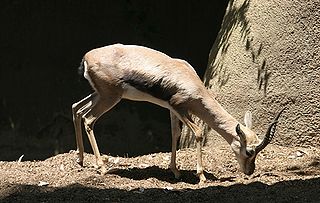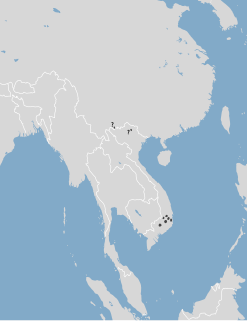
The International Union for Conservation of Nature (IUCN) Red List of Threatened Species, also known as the IUCN Red List or Red Data Book, founded in 1964, is the world's most comprehensive inventory of the global conservation status of biological species. It uses a set of precise criteria to evaluate the extinction risk of thousands of species and subspecies. These criteria are relevant to all species and all regions of the world. With its strong scientific base, the IUCN Red List is recognized as the most authoritative guide to the status of biological diversity. A series of Regional Red Lists are produced by countries or organizations, which assess the risk of extinction to species within a political management unit.

Speke's gazelle is the smallest of the gazelle species. It is confined to the Horn of Africa, where it inhabits stony brush, grass steppes, and semi deserts. This species has been sometimes regarded as a subspecies of the Dorcas gazelle, though this is now widely disregarded. Severe habitat fragmentation means it is now impossible to assess the natural migratory or nomadic patterns of G. spekei. Its numbers are under threat, and despite an increase in population, the IUCN in 2007 announced its status had changed from vulnerable to endangered. A captive population is maintained, and the wild population exists in the lower tens of thousands. As of 2008, this gazelle is classified as endangered under the IUCN Red List.

The conservation status of a group of organisms indicates whether the group still exists and how likely the group is to become extinct in the near future. Many factors are taken into account when assessing conservation status: not simply the number of individuals remaining, but the overall increase or decrease in the population over time, breeding success rates, and known threats. Various systems of conservation status exist and are in use at international, multi-country, national and local levels as well as for consumer use.

A least-concern species is a species that has been categorized by the International Union for Conservation of Nature (IUCN) as evaluated as not being a focus of species conservation because the specific species is still plentiful in the wild. They do not qualify as threatened, near threatened, or conservation dependent.

A near-threatened species is a species which has been categorized as "Near Threatened" (NT) by the International Union for Conservation of Nature as that may be vulnerable to endangerment in the near future, but it does not currently qualify for the threatened status.

A species that is extinct in the wild (EW) is one that has been categorized by the International Union for Conservation of Nature as known only by living members kept in captivity or as a naturalized population outside its historic range due to massive habitat loss.

The small-toothed mole is a species of mammal in the family Talpidae. It is found in Di Linh, in southern Vietnam, and Rakho near the border of Vietnam and China, and in southern Yunnan, China, near the Vietnamese border. It is likely that it has a broader distribution, especially in places between the currently known locations.
Macroperipatus insularis is a species of velvet worm in the Peripatidae family. It may be found in Jamaica, Hispaniola, or Haiti. The female of this species has 20 pairs of legs.
Mesoperipatus is a monospecific genus of velvet worm in the Peripatidae family, containing a single species Mesoperipatus tholloni. It is found in Gabon, making it the only known species of velvet worm in the tropics of Africa, and the only known species of peripatid velvet worm in Africa. Females of this species have 24 to 27 pairs of legs; males have 23 or 24.
Plicatoperipatus is a monospecific genus of velvet worm containing the single species Plicatoperipatus jamaicensis. It is endemic to Jamaica. Males in this species have 35 pairs of legs; females have 43 pairs, the maximum number found in the phylum Onychophora.
Metacyclops campestris is a species of copepod in the family Cyclopidae.
Metacyclops is a genus of copepod crustaceans in the family Cyclopidae, containing 61 species, of which three are listed on the IUCN Red List – M. campestris from Brazil, M. gasparoi from Italy (vulnerable) and M. postojnae from Slovenia (vulnerable).
Metacyclops gasparoi is a species of copepod in the family Cyclopidae.

Typhlocaris ayyaloni is a species of troglobitic shrimp in the family Typhlocarididae.
Microcyclops is a genus of copepods, containing the following species:

Endangered species as classified by the International Union for Conservation of Nature (IUCN), are species which have been categorized as very likely to become extinct in their known native ranges in the near future. On the IUCN Red List, endangered is the second most severe conservation status for wild populations in the IUCN's schema after critically endangered. In 2012, the IUCN Red List featured 3,079 animal and 2,655 plant species as endangered worldwide. The figures for 1998 were 1,102 and 1,197 respectively.






